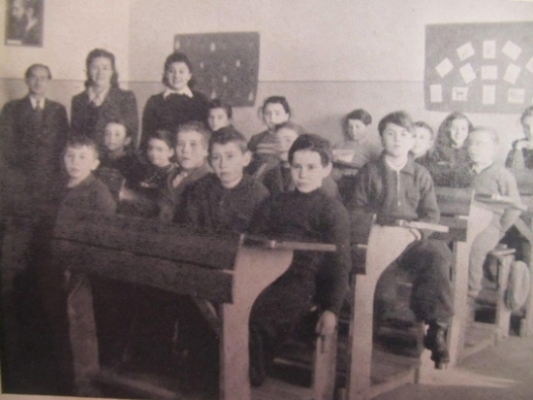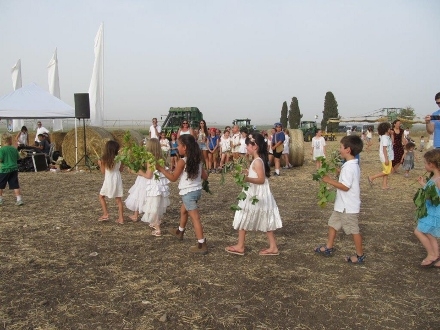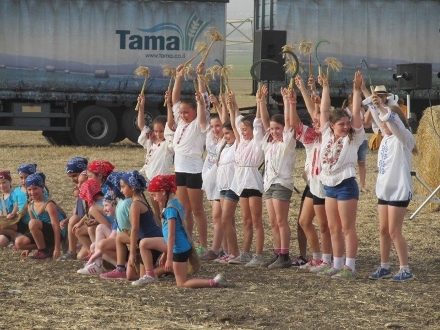Where did these Children end up?
Story and Photos by Lydia Aisenberg
As Shavuot,approaches one of my favorite holidays on the kibbutz where I have resided for almost five decades, I look through the copy of B'Derech in front of me and am mesmerized by a grainy photograph of serious-faced youngsters in a DP camp classroom. They are pretty tightly squashed into wooden bench-desks, most wearing sombre dark clothing, with the teacher standing behind them. The children are all looking towards the front of the class and we can only guess what is going on off camera, but it is noticeable that not one child is smiling.
I begin to wonder how many of these children would have eventually ended up in Israel, or possibly my birthplace - Britain – or maybe America or Australia. Some may have even stayed and built a life in post-Holocaust Germany or other war-torn European countries where DP camps were created. Who knows?
But then of course, there is the distinct possibility that they succeeded in eventually boarding one of the ill-fated ships full of hopeful immigrants and clandestinely headed for Israel – and again, possibly, ending up either back in Europe or in Cyprus in a British detention camp for illegal Jewish immigrants. From camp to camp, Israel so near but yet so far away.
The wondrous publication I am pouring over is one of thousands of equally intriguing and emotional pieces of the past to be found in the Judaica collection of kibbutz-born Israeli collector, sculptor and mastercraftsman, Aviram Paz, who collects items of Jewish interest from the Second World War period.
In this issue of B'Derech, there are a number of pages dealing with the Shavuot holiday, the giving of the Torah to the Jewish people on Mount Sinai thousands of years ago. There are suggestions for quizzes and games with a Shavuot theme and photographs showing barelegged and barefooted young Israeli girls and boys dancing in fields of wheat. The first page dealing with Shavuot is a full-page black and white picture of Mount Sinai and its foothills, tent-dwelling folk in the rocky valley below and a herd of camels wandering off out of view.
"The B'Derech publication was a combined effort of the Jewish Agency, the Joint Distribution Committee Education Department, and the Central Committee of Liberated Jews and it aimed at providing Israeli educators who had gone to Europe from British Mandatory Palestine - mainly members of Zionist movements - with suitable material to teach the children in the camps the Israeli approach to learning about and celebrating the Jewish holidays," explained Paz.
I take a closer look at the serious, sad faces of the children in the classroom. It was taken at the Feldafing Displaced Persons Camp near Munich in 1946.
Located a short distance from Munich in the American zone, Feldafing had been a summer camp for youngsters in the Hitler Youth. The US Army had opened the Feldafing DP camp in May 1945, initially absorbing over 3,000 Hungarian survivors, but after a short period they were joined by non-Jewish DPs also from Hungary, and some from Poland. Through the intervention of Abraham Klausner, an American Reform rabbi and US Army chaplain, it was decided to take the non-Jewish Polish and Hungarian DPs from the camp and give their places to Jewish survivors from the Dachau concentration camp in the same city.
Born in Memphis, Tennessee in 1915, but raised in Denver, Colorado, Klausner was one of five children born to a Hungarian immigrant father and Austrian mother. Just a few days after the 1945 liberaton of Dachau, Rabbi Klausner (who died in 2007 at the age of 92) entered the concentration camp and earned a reputation as a strong advocate for thousands of the survivors who remained in DP camps for years after the war.
It was at Feldafing that the Joint Distribution Committee created the first all-Jewish hospital in a German displaced persons camp. The facility boasted over a thousand beds.
Religious institutions, schools and a yeshiva were created in Feldafing, a nursing school and ORT Vocational Training School established and for those who wanted it, there was the opportunity to attend secular adult education classes in the evenings. Around 450 children and teens lived in a separate part of the camp alongside European teachers and emissaries from the Israeli Zionist movements which worked with them, successfully organizing Zionist- orientated groups with a view to joining secular as well as religious kibbutzim when aliyah to Israel became possible.
"The magazine was published in Munich and on the heading it says, in rather small print, that it is intended for children in Germany, Austria, Italy and Belgium. It also mentions Morocco and Tunisia," explains Paz.
"There was a great effort made to provide educational content not only about the holidays, but also about Israeli history and its heritage and culture together with short stories about characters that the children could easily identify with, especially those waiting to be taken to Israel with Aliyat HaNoar," said Paz.
"In every publication there was a sizeable corner given to the Keren Kayemeth LeIsrael (JNF) who used the opportunity to introduce the children to the importance of nature, the land and forests of Israel.
"Emissaries from Israel worked industriously to bring the Israeli flavor to all the holidays in particular, and their work is strongly felt in these publications. The Zionist messages are practically shouting from the pages," Paz comments and turns the page to a short story with the heading A Visit to My Soldier Uncle."
This Shavuot holiday, as I watch my grandchildren parade around the kibbutz fields carrying sheaves of wheat - broad smiles on their faces, the kibbutz choir singing in full volume as they proudly stand on a stage set up in the middle of a Jezreel Valley field, I will be thinking of the children from Feldafing, wherever they might be in modern times.
Educational and religious life flourished in Feldafing. In addition to Feldafing's secular elementary and high school systems, the camp's religious community founded several schools, including a Talmud Torah (religious elementary school), a yeshiva (religious academy), and several seminaries, including Beit Midrash Lita and Bet Midrash Ungarn. Feldafing also had a rabbinical council that supported its religious office, an agency that held considerable influence within the camp. The camp's extensive library had a noteworthy religious book collection.
Several newspapers were published in Feldafing, including Dos Fraje Wort (The Free Word) and Dos Jiddishe Wort (The Jewish Word) as well as supplementary magazines like the Feldafinger Magazin. Theater troupes such as the Partisans and Habima entertained the camp population. Camp residents also organized an orchestra.
General Dwight D. Eisenhower personally inspected the living conditions of Feldafing in September 1945. The hospital, as well as additional housing, were a direct result of the Harrison report and Eisenhower's visit to the camp. Footage of Eisenhower's visit shows crowds of survivors surrounding him, much as they did when Jewish leaders like David Ben-Gurion visited the camp. Ben-Gurion's initial visit to the camp in October 1945 was an important boost of confidence to the population of Feldafing and its central committee. As the first all-Jewish DP camp in the US zone, Feldafing also marked the site of the first elected Jewish camp committee.
Feldafing's camp committee was subdivided into several offices, including staffs for housing, provisions, economics, sanitation, culture and legal matters. The strong camp court launched a project to codify laws for the camp in 1946 and led a movement to standardize the law for all the refugees in the US zone of Germany. (The Jewish displaced persons called themselves the She'erit ha-Pletah, a Hebrew term of biblical origin,meaning "Surviving Remnant".) The court also issued decisions concerning several former kapos living within the camp. The Feldafing court helped investigate the perpetrators of the Kielce pogrom of 1946 and publicized information about the Nazi murderers of Lithuanian Jews who were thought to have been in the vicinity. In 1946 about 4,000 Jews lived at Feldafing, and by Passover 1951, there were 1,585 Jewish DPs remaining in the camp. The camp went over to German administration on December 1, 1951, and closed in March l953.
This article is based on the exhibition Life Reborn: Jewish Displaced Persons 1945-1951, a project of the United States Holocaust Memorial Council and the Second Generation Advisory Group.











Comments